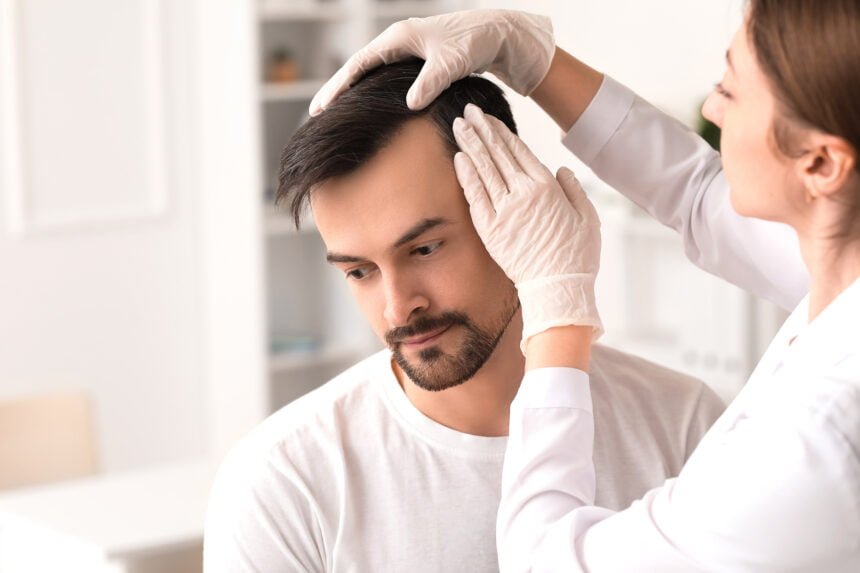Going bald? You’re not alone. For most men, losing your hair as you age is as inevitable as earning those distinguished grey hairs in your beard. But while a receding hairline may seem like a rite of passage for guys, it pays to understand the health implications behind your changing locks.
According to medical studies, two-thirds of men may experience some degree of hair loss by age 35. And by age 50, about 85% of men will experience thinning hair. Although it can be just a cosmetic nuisance for some, hair loss can also point out some underlying health conditions that need attention. Thankfully, in the present, men today have now more options than ever before to slow down hair loss or even regrow it. Some science-backed treatments and significant lifestyle changes can help you take control of your hairline and reduce hair loss.
But first, it’s important to understand what causes that progressive thinning up top in the first place. Keep reading as this blog discusses the context of hair loss, as well as some insider tips to keep your hair healthy and looking at its best at any age.
The Anatomy Of Hair Loss
Each hair strand develops and grows out of a follicle under the skin surface. The follicle itself is made up of multiple layers of cells. These cells are constantly dividing to spur the production of new hair cells. Meanwhile, the hair loss problem starts when the follicle begins to shrink, producing thinner and weaker hairs over time. This shrinking is medically known as follicular miniaturization. Eventually, the follicle may shrink so much that new hair growth is restricted altogether, and the stages of hair loss start.
The Stages Of Hair Loss
Hair loss often occurs in predictable patterns as it progresses. Doctors use standardized systems to classify these stages of baldness. For male pattern baldness, the Hamilton-Norwood scale is commonly used. This system categorizes hair loss in seven stages based on the location and extent of receding hairlines.
During the earliest stages of hair loss, you may notice a widening part or slight temple recession, but retain most of your hair. Moderate thinning typically starts behind the hairline’s peaks, creating an “M” shape. This progresses to more severe thinning and balding on the crown in the advanced stages.
Familiarizing these stages can help you catch hair loss early and start treatment. It also allows you to gauge how well treatments are working to maintain or regrow hair.
Causes Of Hair Loss
- Androgenetic Alopecia
You’ve probably heard the term “male pattern baldness” – but what exactly causes it? This common type of hair loss has a long scientific name, androgenetic alopecia. Studies report that this common hair loss condition can happen in roughly 50% of men and 13% of premenopausal women.
Androgenetic refers to the androgens or male hormones like testosterone. These hormones can bind to receptors in your scalp, causing hair follicles to shrink over time. Meanwhile, genetic hints that your DNA also plays a role. This means that male pattern baldness can run in families.
While frustrating, androgenetic alopecia itself isn’t dangerous, just cosmetically annoying. It does provide a clue, though, that your androgens may be out of balance. So, if you’re losing hair early, get your hormone levels checked. Treatments for androgenetic alopecia are available to help stop or slow down the miniaturization process and stimulate regrowth. Hair transplant surgery can also redistribute hair from unaffected areas of the scalp to areas with significant hair loss.
- Diet and nutritional deficiencies
While genetics play a big role in hair loss, poor nutrition may accelerate the process. Skimping on key nutrients can starve your follicles, leading to increased shedding and thinning. Protein is your hair’s best friend. Without enough of it, your strands end up brittle and break off easily. Iron also pumps up those follicles. Low iron levels can trigger excessive hair fall.
Eating a colour-filled rainbow diet with veggies, fruits, healthy fats, and lean proteins ensures you conceal all your nutritional bases. The better you eat, the better your hair looks.
- Stress
Stress and hair loss have been studied and proven to be related. Anything that triggers high cortisol and inflammation can zap hair follicles. Here’s how it happens: stress flips hair growth into rest mode. More hairs than normal stop growing and shed. If this continues long-term, noticeable thinning can set in.
Managing stress can help reverse the damage. So, keep your mind chilled, and you can hang on to those strands longer.
Medical Conditions Causing Hair Loss
Sometimes, hair loss can happen due to an underlying medical condition. Getting an accurate diagnosis and treatment from your doctor can help stop or reverse this type of hair loss.
Common medical reasons for hair loss include:
- Thyroid disorders
Both hyperthyroidism and hypothyroidism can initiate hair loss. Your healthcare provider can test your thyroid hormone levels with a simple blood screening. Medications can also help normalize thyroid function.
- Anaemia
Low iron levels from iron deficiency anaemia deprive your hair follicles of necessary oxygen and nutrients.
- Alopecia areata
This autoimmune condition causes patches of baldness when the immune system attacks the hair follicles. Corticosteroid injections may help regrow your hair.
- Ringworm infection
A fungal infection can lead to hair loss if not treated promptly. Antifungal medications may help clear up the infection.
- Trichotillomania
Compulsive hair-pulling eventually leads to noticeable bald patches. Counselling and behaviour therapy can help reverse this body-focused repetitive behaviour.
Don’t hesitate to see a dermatologist if sudden, patchy, or unexplained hair loss occurs. Identifying and treating any of these underlying causes can help regrow healthy hair.
The Bottom Line
Hair loss can initially affect your confidence, but thankfully, you’ve got options to fight back. Understanding the common causes can help you detect hair loss problems early. So, focus on improving your diet, managing stress, and using preventative hair loss treatments. With the right lifestyle measures and working with your doctor, you can reduce hair loss progression.










